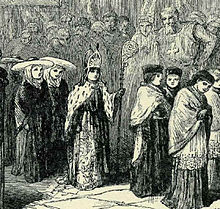
The Feast of Fools or Festival of Fools (Latin: festum fatuorum, festum stultorum) was a feast day on January 1 celebrated by the clergy in Europe during the Middle Ages, initially in Southern France, but later more widely.[1] During the Feast, participants would elect either a false Bishop, false Archbishop, or false Pope.[2][3] Ecclesiastical ritual would also be parodied, and higher and lower-level clergy would change places.[2][3] The lack of surviving documents or accounts, as well as changing cultural and religious norms, has considerably obscured the modern understanding of the Feast, which originated in proper liturgical observance, and has more to do with other examples of medieval liturgical drama, though there is some connection with the earlier pagan (Roman) feasts of Saturnalia and Kalends or the later bourgeois in Sotie.[4] Over the course of a week, the ceremonies would be led by different people in positions of power within the church. On December 26, St. Stephen's Day, the deacons led the ceremonies. The sub-priests (or vicars) were in charge on December 27, St. John's Day, the choirboys on December 28, Holy Innocents’ Day, and the sub-deacons on the first of January, the Feast of the Circumcision.[5] There is some disagreement on whether the term Feast of Fools was originally used to refer to the collection of days[5] or specifically the celebrations taking place on the first of January.[6] The word "fool" is used as a synonym for humble, as was common in the 11th century, rather than the modern use that treats it as another term for clown or jester.[4]
- ^ "Overture". The Feast of Fools. Harvard University Press. 1 October 2013. pp. 3–6. doi:10.4159/harvard.9780674285002.c1. ISBN 978-0-674-28500-2.
- ^ a b "Feast of Fools | medieval festival | Britannica". www.britannica.com. Retrieved 28 September 2022.
- ^ a b Green, Joseph L. (2011). The Power of the Original Church : Turning the World Upside Down. Shippensburg: Destiny Image, Inc. ISBN 978-0-7684-9004-6. OCLC 781613685.
- ^ a b Harris, Max (2011). Sacred folly : a new history of the Feast of Fools. Ithaca [N.Y.]: Cornell University Press. ISBN 978-0-8014-6161-3. OCLC 732957185.
- ^ a b Gulevich, Tanya (1 June 2000). Encyclopedia of Christmas: nearly 200 alphabetically arranged entries covering all aspects of Christmas ... Michigan: Omnigraphics.
- ^ Thompson, Sue Ellen (1998). Holiday Symbols (1st ed.). Detroit, Michigan: Omnigraphics. pp. 125–128.